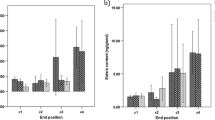Summary
The inheritance of a group character, the alarm behaviour of honey bee workers (Apis mellifera L.), was analyzed using a metabolic bio-assay. In a diallel test cross of preselected queens and drones, genetic variance and maternal effects on this behaviour were estimated. Crossfostering experiments showed that the hive environment during larval and pupal development has only minor effects on alarm behaviour.
Zusammenfassung
Die Vererbung eines Gruppenmerkmales, der Alarmierungsreaktion von Arbeiterinnen (Apis mellifera L.) wurde in einem quantitativen Stoffwechseltest überprüft. In einer diallelen Testkreuzung von selektierten Königinnen und Drohnen konnten genetische Varianzkomponenten sowie maternale Effekte geschätzt werden. Experimente, in denen Eier von fremden Pflegevölkern zu Imagines aufgezogen wurden, zeigten, dass die Stockumwelt während der Larval-und Pupalentwicklung keinen Einfluss auf das spätere Alarmverhalten der Arbeiterinnen nimmt.
Similar content being viewed by others
References
Chauvin R., 1981. — La «survivone» substance qui induit la survie des abeilles isolées.Ins. Soc., 28, 223–231.
Collins A.M., 1979. — Genetics of the response of the honeybee to an alarm chemical, isopentyl acetate.J. Apic. Res., 18, 285–291.
Collins A.M., 1982. — Behaviour genetic of honey bee alarm communication, pp. 307–311, in:The biology of social insects. Ed. Breed, M.D.et al. Westview Press, Boulder, Colorado.
Collins A.M., Rinderer T.E., Harbo J.R., Bolton A.B., 1982 — Colony defense by Africanized and European honey bees.Science, 218, 72–77.
Collins A.M., Rinderer T.E., Harbo J.R., Brown M.A., 1984. — Heritabilities and correlations for several characters of the honeybee.J. Hered., 75, 135–140.
Dickerson G.E., 1962. — Implications of genetic-environmental interaction in animal breeding.Anim. Prod., 4, 47–55.
Falconer D.S., 1980. —Introduction to quantitative genetics, 2nd edn. Longman, London, New York.
Gordon D.M., 1982. — Social context: If ant behaviour depends on it, should our methods be leaving it out? pp. 396–397, in:The biology of social insects, Ed. Breed, M.D.et al. Westview Press, Boulder, Colorado.
Koeniger G., 1986. — Reproduction ofApis mellifera, pp. 255–282, in:Bee breeding and genetics, Ed. Rinderer, T.E. Academic Press, New York.
Laidlaw H.H., Page R.E., 1984. — Polyandry in honey bees (Apis mellifera L.): Sperm utilization and intracolony relationship.Genetics, 108, 985–997.
Lindauer M., 1954. — Temperaturregulierung und Wasserhaushalt im Bienenstaat.Z. vergl. Physiol., 36, 391–432.
Maschwitz U., 1964. — Gefahrenalarmstoffe und Gefahrenalarmierung bei sozialen Hynopteren.Z. vergl. Physiol., 47, 596–655.
Moritz R.F.A., 1982. — Maternale Effekte bei der Honigbiene (Apis mellifera L.).Z. Tierzuecht, Zuechtungsbiol., 99, 139–148.
Moritz R.F.A., 1983. — Homogenous mixing of honeybee semen by centrifigation.J. Apic. Res., 22, 249–255.
Moritz R.F.A., 1985. — Heritability of the port copping stage inApis mellifera L. and its relation toVarroatose resistance.J. Hered., 76, 267–270.
Moritz R.F.A., 1986. — Estimating genetic variance of group characters: social behaviour in honey bees (Apis mellifera L.).Theor. Appl. Genet., 72, 513–517.
Moritz R.F.A., 1986b. — Intracolonial worker relationship and sperm competition in the honey bee workers (Apis mellifera L.).Behav. Ecol. Sociobiol., 21, 53–57.
Moritz R.F.A., Klepsch A., 1985. — Estimating heritabilities of worker characters. A new approach using laying workers of the Cape honeybee (Apis mellifera capensis Esch.).Apidologie, 16, 47–56.
Moritz R.F.A., Southwick E.E., 1987. — Phenotype interactions in group behaviour of honey bee workers (Apis mellifera L.)Behav. Ecol. Sociobiol., 21, 53–57.
Moritz R.F.A., Southwick E.E., Breh M., 1985. — A metabolic test for the quantitative analysis of alarm behaviour in the honey bee (Apis mellifera L.).J. Exp. Zool., 235, 1–5.
Oldroyd B., Moran C., 1983. — Heritability of worker characters in the honeybee (Apis mellifera L.).Aust. J. Sci., 36, 323–332.
Pirchner F., Ruttner F., Ruttner H., 1962. — Erbliche Unterschiede zwischen Ertragseigenschaften von Bienen.21st Int. Cong. Entomol., Vienna, Vol. 2, 510–516.
Rinderer T.E., Collins A.M., Brown M.A., 1983. — Heritabilities and correlations of the honeybee: Response toNosema apis, longevity and alarm response to isopentyl acetate.Apidologie, 14, 79–85.
Riska B., Rutledge J.J., Atchley W.R., 1985. — Genetic analysis of crossforstering data with sire and dam records.J. Hered., 76, 247–250.
Ritter W., 1982. — Experimenteller Beitrag zur Thermoregulation des Bienenvolkes (Apis mellifera L.).Apidologie, 13, 169–185.
Sander K., 1984. — Maternal effects on insect development. In.Advances in invertebrate reproduction 3. Ed.: Engels W. Elsevier Publ. Amsterdam, New York.
Seeley T.E., 1974. — Atmospheric carbon dioxide regulation in honey-bee (Apis mellifera) colonies.J. Insect. Physiol., 20, 2301–2305.
Sitbon G., 1967. — L'effet de groupe et la mortalité des abeilles isolées ou groupées.Ann. Abeille, 10, 67–82.
Sitbon G., 1971. — Corpora allata, neurosécrétion et effet de groupe chez l'abeille d'hiver.Ins. Soc., 18, 161–172.
Soller M., Bar Cohen N.G., 1968. — Some observations on the heritability and genetic correlation between honey production and brood area in the honeybee.J. Apic. Res., 6, 37–43.
Southwick E.E., 1985. — Allometric relations, metabolism and heat conductance in clusters of honey bees at cool temperatures.J. Comp. Physiol., 156, 143–149.
Southwick E.E., Moritz R.F.A., 1985. — Metabolic response to alarm pheromone in honey bees.J. Insect. Physiol., 31, 389–392.
Southwick E.E., Mugaas J.W., 1971. — A hypothetical homeotherm. The honey bee hive.Comp. Biochem. Physiol., 46 A, 935–944.
Stort A.C., 1974. — Genetic study of aggressiveness of two subspecies ofApis mellifera in Brazil. 1. Some tests to measure aggressiveness.J. Apic. Res., 13, 33–38.
Willham R.L., 1964. — The covariance between relatives for characters composed of contributed by related individuals.Biometrics, 19, 18–25.
Author information
Authors and Affiliations
Rights and permissions
About this article
Cite this article
Moritz, R.F.A., Southwick, E.E. & Harbo, J.R. Maternal and pre eclosional factors affecting alarm behaviour in adult honey bees (Apis mellifera L.). Ins. Soc 34, 298–307 (1987). https://doi.org/10.1007/BF02224362
Received:
Accepted:
Issue Date:
DOI: https://doi.org/10.1007/BF02224362




